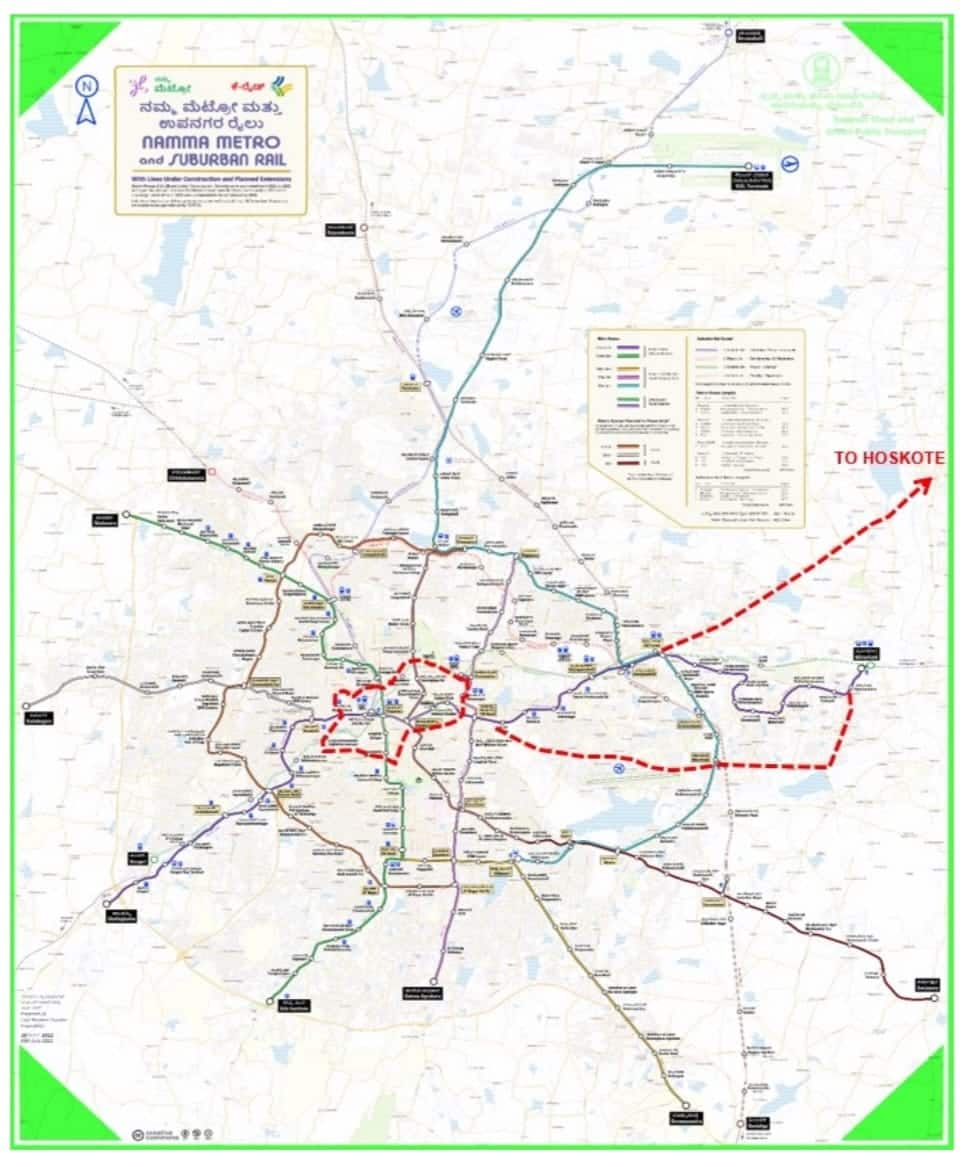



Setting a roadmap for Karnataka's trillion-dollar ambition, the state government and Federation of Indian Chambers of Commerce & Industry (FICCI) on September 22 released a report suggesting several measures to address traffic congestion in Bengaluru.
Among the measures, they have proposed three new Metro corridors in Bengaluru: Old Airport Road (MG Road to Hope Farm via Marathahalli and Whitefield), Old Madras Road (KR Puram to Hoskote - Narsapura industrial area connectivity) and Inner Ring Road loop. Inner Ring Road loop will connect places like Yeshwantpur, Cantonment, Indiranagar, Koramangala, Ashoka Pillar and Mahalakshmi Layout.
Bengaluru residents may get Metro access within 1-2 km from their home or place of work by 2032
“The objective of the metro network is to provide metro access to every citizen of Bengaluru within one to two kilometers of their place of work or residence by 2032,” it said.

In the earlier draft report, it had proposed Metro corridors like Nagawara - Kempegowda International Airport via Thanisandra / Bharatiya City, Whitefield - Katamanallur/Hoskote, and an extension of the Bannerghatta line to Jigani. However, these are not included in the final report.
In addition to the under-construction Metro corridors (Nagasandra- BIEC, Kalena Agrahara – Nagawara, RV Road – Bommasandra, Central Silk Board – KR Puram – Kempegowda International Airport), detailed project report for two corridors (JP Nagar 4th Phase-Kempapura along ORR West and Hosahalli-Kadabagere along Magadi Road) has been submitted to the Central government. The preparation of the DPR for another corridor, Hebbal-Sarjapur Road, is on.
Separately, Karnataka Rail Infrastructure Development Company (K-RIDE), the executing agency for the Bengaluru Suburban Rail Project (BSRP), has prepared a proposal to expand the network to nearby cities and towns of Bengaluru.
According to the proposal, suburban rail will be extended from Devanahalli to Kolar (107 km), Chikkabanavara to Tumakuru via Dobbaspet (55 km), Kengeri to Mysuru (125 km), Whitefield to Bangarpet (45 km), Heelalige to Hosur (23 km), Rajanukunte to Gauribidanur via Doddaballapur (52 km) Additionally, a new line, 'corridor 2A,' is proposed from Chikkabanavara to Magadi (45 km).
Also read: Bengaluru suburban rail's Phase 2 to cover 452 km; Karnataka seeks nod from rail ministry
The report also suggested to create ‘8-to-80’ Bengaluru. “Cities that embrace the ‘8-to-80’ approach have streets that can be used by people independently, from the age of eight years old to 80. Usage can range from an eight-year-old riding their bike to school to an 80-year-old walking to the shops. Everyone can move about the city in a safe, convenient, and enjoyable manner.”, it said.
The report also suggested integrated fares for commute. “If payment systems are integrated, passengers can pay once for trips that include multiple public transit modes. Smart ticketing systems automatically adjust the fare that is charged to reflect each passenger’s specific journey and travel frequency,” it said.
Congestion pricing
The report also recommended imposing congestion pricing on major roads. “A congestion charge in the city, applicable to all non-exempt vehicles entering Bengaluru during busy periods, could be implemented with the aim of reducing traffic congestion and improving journey times for buses, cars, and delivery vehicles,” it said.
“The objective would be to make users conscious of the costs they impose on one another when they take to the road during peak hours", it said.
At present, there are nine entry points to the inner city where the congestion charge could be levied: Bellari Road, Tumukuru Road, Magadi Road, Mysuru Road, Kanakapura Road, Bannerghatta Road, Hosur Road, Old Madras Road, and Old Airport Road, it said.
“At present, 12 million vehicles travel into the city of Bengaluru every day. Levying a congestion charge could translate into significant revenue for the city. Fastag has been successfully deployed in the city since 2021. It is proposed that the same mode be used to collect congestion charges in the city for ease and convenience,” it said.
“The money from the congestion charge can be spent on other forms of public transport. Reduction in congestion equals a reduction in time wasted and reduces costs for commuters and businesses. Fewer cars will lead to less pollution, making city centers more attractive for pedestrians and cyclists. This would help to improve the quality of life,” it said.
Intelligent City
The report said that one of Bengaluru’s broad objectives is to become an ‘intelligent city’. “This may entail focused intervention in many initiatives, including the development of a unified mobile application for transport. With it, commuters can plan their trips efficiently, from start to finish. The development of a world-class transportation infrastructure entails the provision of information, allowing commuters to make informed decisions. Information could be disseminated via several media, physical and digital signage systems, information systems, timing displays at bus stops, and information on mobile applications”, the report adds
Discover the latest Business News, Sensex, and Nifty updates. Obtain Personal Finance insights, tax queries, and expert opinions on Moneycontrol or download the Moneycontrol App to stay updated!
Find the best of Al News in one place, specially curated for you every weekend.
Stay on top of the latest tech trends and biggest startup news.